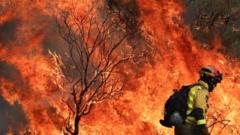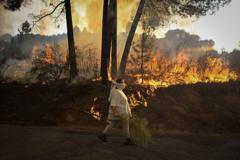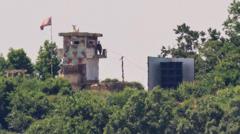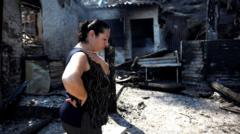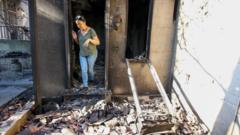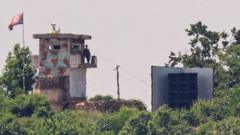As South Korea grapples with its largest wildfires on record, rescue efforts are underway to protect people and cultural treasures from the flames that have claimed 27 lives.
South Korea Faces Destruction Amid Historic Wildfires

South Korea Faces Destruction Amid Historic Wildfires
Devastating wildfires in South Korea have resulted in significant loss of life and damage to cherished heritage sites.
Article Text:
In the grip of catastrophic wildfires, South Korea is witnessing the most severe blaze in its history, now extending into the seventh day of devastation. As firefighters, emergency responders, and cultural guardians mobilize to combat the flames, the urgency to safeguard both the populace and the nation’s priceless artifacts has never been greater.
With approximately 37,000 residents evacuated from the rapidly spreading infernos, the loss of life has already tragically reached 27. The wildfires have ravaged over 88,000 acres in the southeast region, marking an unprecedented event according to the Interior Ministry. Notably, the largest blaze, situated in Euiseong County, continues to be a significant threat as it is only partially contained.
While prioritizing rescue operations, crews are also intensifying their efforts to protect South Korea's cultural heritage. The blazes have already consumed two ancient Buddhist temples that stood for a millennium, alongside numerous other culturally significant sites. Approximately 20 structures and items classified as national heritage have been destroyed amidst the flames, as reported by the Korea Heritage Service, which shoulders the responsibility of safeguarding these treasures.
Noteworthy amongst the losses is the Gounsa Temple, where the main shrine managed to evade the flames, yet many adjacent buildings were not so fortunate. A priceless early 9th-century statue of a Buddha has been reduced to ashes, while a 400-year-old tree, revered as the guardian of a nearby village, has been left charred.
In response to the catastrophe, the heritage service has deployed an army of 750 personnel to the affected areas, focusing on either protecting remaining cultural artifacts or safely relocating them. The southeastern region of South Korea is particularly significant, housing a substantial number of the nation’s 4,000 recognized cultural properties. As the community rallies to navigate this tragedy, the resilience of heritage and the spirit of the people will be put to the ultimate test.
In the grip of catastrophic wildfires, South Korea is witnessing the most severe blaze in its history, now extending into the seventh day of devastation. As firefighters, emergency responders, and cultural guardians mobilize to combat the flames, the urgency to safeguard both the populace and the nation’s priceless artifacts has never been greater.
With approximately 37,000 residents evacuated from the rapidly spreading infernos, the loss of life has already tragically reached 27. The wildfires have ravaged over 88,000 acres in the southeast region, marking an unprecedented event according to the Interior Ministry. Notably, the largest blaze, situated in Euiseong County, continues to be a significant threat as it is only partially contained.
While prioritizing rescue operations, crews are also intensifying their efforts to protect South Korea's cultural heritage. The blazes have already consumed two ancient Buddhist temples that stood for a millennium, alongside numerous other culturally significant sites. Approximately 20 structures and items classified as national heritage have been destroyed amidst the flames, as reported by the Korea Heritage Service, which shoulders the responsibility of safeguarding these treasures.
Noteworthy amongst the losses is the Gounsa Temple, where the main shrine managed to evade the flames, yet many adjacent buildings were not so fortunate. A priceless early 9th-century statue of a Buddha has been reduced to ashes, while a 400-year-old tree, revered as the guardian of a nearby village, has been left charred.
In response to the catastrophe, the heritage service has deployed an army of 750 personnel to the affected areas, focusing on either protecting remaining cultural artifacts or safely relocating them. The southeastern region of South Korea is particularly significant, housing a substantial number of the nation’s 4,000 recognized cultural properties. As the community rallies to navigate this tragedy, the resilience of heritage and the spirit of the people will be put to the ultimate test.


